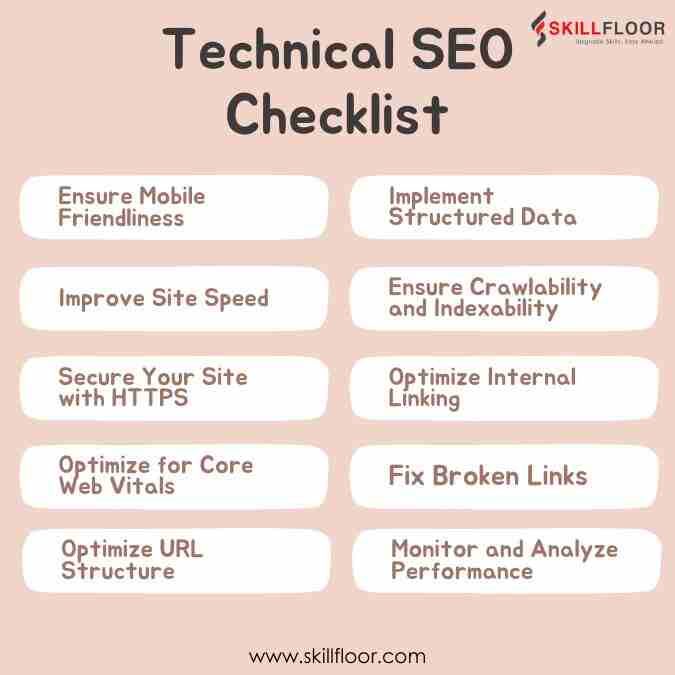The Ultimate Technical SEO Checklist
Discover the ultimate technical SEO checklist for optimizing your website's technical aspects. Ensure better search engine visibility and performance.

Keeping up with search engine optimization can be tricky, but having a Technical SEO Checklist can make it easier to manage your website’s health in 2024. Start by performing a site audit to find any issues like broken links, duplicate content, or pages that load slowly. It's important to ensure your site is mobile-friendly since search engines favor websites that work well on all devices. Focus on core web vitals, such as how fast your page loads and how stable it is as it loads, to improve your ranking. Including these steps in your Technical SEO Checklist will help build a solid base for your digital marketing efforts.
Besides these basics, it's essential to improve your website's crawlability and indexability. Use structured data to help search engines understand your content better, and keep your XML sitemap up-to-date and submitted to Google Search Console. Regularly check for crawl errors and fix them so search engines can access all your important pages. Also, make sure your site is secure with HTTPS and keep an eye out for malware or hacking attempts. Following this Technical SEO Checklist can boost your site’s performance and straightforwardly support your digital marketing strategy.
1. Ensure Mobile Friendliness
Mobile-first indexing has become the standard. With mobile devices accounting for a substantial amount of web traffic, Google primarily indexes and ranks mobile content. To make your site mobile-friendly:
-
Responsive Design: Ensure that your website changes smoothly to multiple screen sizes.
-
Mobile Usability: Use tools such as Google's Mobile-Friendly Test to discover and resolve issues.
-
Touch-Friendly Elements: Make buttons and links easy to tap on smaller screens.
2. Improve Site Speed
Website speed affects both user experience and search rankings. Slow-loading pages can increase bounce rates and reduce conversions. Key steps for improving site speed include:
-
Optimize Images: Using programs like TinyPNG, you can compress images without losing quality.
-
Enable Browser Caching: Store portions of your website in users' browsers to minimize load times for repeat visitors.
-
Minimize HTTP Requests: Reduce the number of components on each page to reduce the number of queries to the server.
3. Secure Your Site with HTTPS
Security is a priority for search engines and users alike. Having a secure website not only protects user data but also positively impacts your rankings. Ensure your website is secure by:
-
SSL Certificate: Install an SSL certificate to switch your site from HTTP to HTTPS.
-
Mixed Content Issues: Avoid loading insecure content (HTTP) on secure pages (HTTPS).
4. Optimize for Core Web Vitals
Core Web Vitals are metrics related to speed, responsiveness, and visual stability. These metrics are now a part of Google's ranking criteria, making them essential for technical SEO:
-
Largest Contentful Paint (LCP): Measures loading performance. Aim for LCP to occur within 2.5 seconds of when the page starts loading.
-
First Input Delay (FID): Measures interactivity. Pages should have an FID of less than 100 milliseconds.
-
Cumulative Layout Shift (CLS): Measures visual stability. Maintain a CLS of less than 0.1 to ensure that the page doesn’t shift unexpectedly.
5. Optimize URL Structure
A precise and succinct URL structure assists search engines in determining the hierarchy of your website's content. The best strategies for URL optimization include:
-
Readable URLs: Use descriptive and keyword-rich URLs to help readers and search engines understand what the page is about.
-
Avoid Special Characters: Keep URLs clear and avoid using special characters, which can cause problems.
-
Use hyphens: Separate words in URLs instead of underscores.
6. Implement Structured Data
Structured data, also known as schema markup, helps search engines understand the content of your pages. It can also improve your search listings with detailed results:
-
Use Schema Markup: Include schema types that are related to your content, such as Articles, Reviews, and FAQs.
-
Validate Markup: Use tools such as Google's Rich Results Test to verify and validate your structured data.
7. Ensure Crawlability and Indexability
Search engines must crawl and index your website before it appears in search results. Ensure that there are no obstacles to this procedure by:
-
Submit Sitemap: To assist search engines locate your pages, create and submit a sitemap through Google Search Console.
-
Robots.txt: Use the robots.txt file to specify which pages or sections of your website search engines should not crawl. If you are not sure how to create one, then use a Robots.txt generator to get started.
-
Crawl Errors: Check Google Search Console regularly for crawl errors and resolve any issues that arise.
8. Optimize Internal Linking
Internal linking plays a vital role in distributing link equity throughout your site and guiding search engines to your important pages. Key strategies include:
-
Use Descriptive Anchor Text: Make sure the anchor text is relevant to the linked page’s content.
-
Avoid Orphan Pages: Ensure all pages are linked from at least one other page within your site.
-
Balance Link Depth: Important pages should be reachable within a few clicks from the homepage.
9. Fix Broken Links
Broken links can have a detrimental influence on both user experience and SEO. Regularly scan your site to identify and fix broken links:
-
Use Tools: Use tools like Screaming Frog to detect broken links on your website.
-
Redirects: Create 301 redirects for any pages that have been moved or deleted.
-
Update Internal Links: Fix any internal links that lead to broken sites.
10. Monitor and Analyze Performance
Continuous monitoring and analysis are critical for maintaining and improving your SEO efforts. Use these tools and approaches to keep track of your site's performance:
-
Google Analytics: Monitor your website's traffic, user behavior, and conversion rates.
-
Google Search Console: Track your site's position in Google search results, look for issues, and improve performance.
-
SEO Tools: Ahrefs, SEMrush, and Moz are examples of SEO tools that may be used to evaluate backlinks, track keyword ranks, and do site audits.

How Often Should I Update My XML Sitemap?
Updating your XML sitemap is essential for ensuring maximum search engine presence. When you add or remove major information from your website, such as new pages, blog posts, or product listings, make sure to update your XML sitemap. This guarantees that search engines accurately index your most recent content. Regular updates to the sitemap indicate to search engines that your site is active and evolving, which can improve your rankings. An up-to-date sitemap also helps search engines understand your site's structure and prioritize important content. Automating this process with solutions such as Yoast SEO or plugins can make management easier, ensuring that your sitemap is always up to date with minimal effort. Regularly maintaining your sitemap promotes successful SEO and improves user discovery.
As we move into 2024, technical SEO remains a critical component of a strong digital marketing plan. Following this complete checklist will ensure that your website is not just search engine optimized, but also offers a smooth and safe user experience. Keep up with the latest trends and practices to maintain and increase your site's visibility and performance. Remember that SEO is a continuous process, and being current on the latest advancements is critical to long-term success. Implementing these technical SEO methods will help you get higher ranks and drive more organic visitors in 2024.




























































